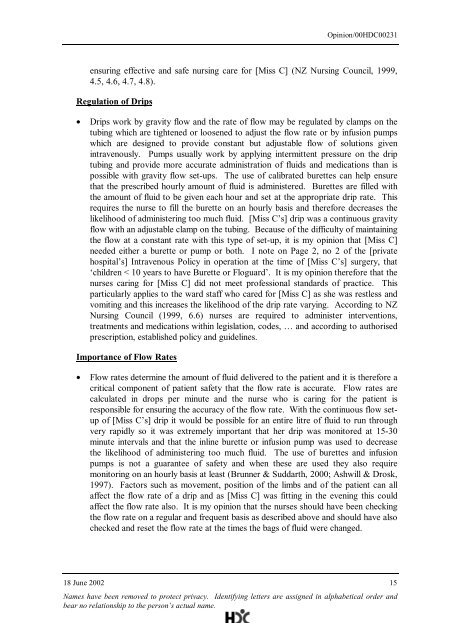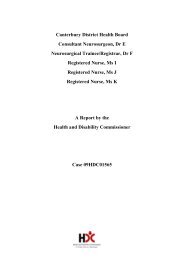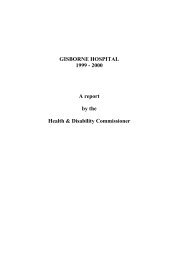Download the pdf version of this decision. - Health and Disability ...
Download the pdf version of this decision. - Health and Disability ...
Download the pdf version of this decision. - Health and Disability ...
Create successful ePaper yourself
Turn your PDF publications into a flip-book with our unique Google optimized e-Paper software.
Opinion/00HDC00231<br />
ensuring effective <strong>and</strong> safe nursing care for [Miss C] (NZ Nursing Council, 1999,<br />
4.5, 4.6, 4.7, 4.8).<br />
Regulation <strong>of</strong> Drips<br />
• Drips work by gravity flow <strong>and</strong> <strong>the</strong> rate <strong>of</strong> flow may be regulated by clamps on <strong>the</strong><br />
tubing which are tightened or loosened to adjust <strong>the</strong> flow rate or by infusion pumps<br />
which are designed to provide constant but adjustable flow <strong>of</strong> solutions given<br />
intravenously. Pumps usually work by applying intermittent pressure on <strong>the</strong> drip<br />
tubing <strong>and</strong> provide more accurate administration <strong>of</strong> fluids <strong>and</strong> medications than is<br />
possible with gravity flow set-ups. The use <strong>of</strong> calibrated burettes can help ensure<br />
that <strong>the</strong> prescribed hourly amount <strong>of</strong> fluid is administered. Burettes are filled with<br />
<strong>the</strong> amount <strong>of</strong> fluid to be given each hour <strong>and</strong> set at <strong>the</strong> appropriate drip rate. This<br />
requires <strong>the</strong> nurse to fill <strong>the</strong> burette on an hourly basis <strong>and</strong> <strong>the</strong>refore decreases <strong>the</strong><br />
likelihood <strong>of</strong> administering too much fluid. [Miss C’s] drip was a continuous gravity<br />
flow with an adjustable clamp on <strong>the</strong> tubing. Because <strong>of</strong> <strong>the</strong> difficulty <strong>of</strong> maintaining<br />
<strong>the</strong> flow at a constant rate with <strong>this</strong> type <strong>of</strong> set-up, it is my opinion that [Miss C]<br />
needed ei<strong>the</strong>r a burette or pump or both. I note on Page 2, no 2 <strong>of</strong> <strong>the</strong> [private<br />
hospital’s] Intravenous Policy in operation at <strong>the</strong> time <strong>of</strong> [Miss C’s] surgery, that<br />
‘children < 10 years to have Burette or Floguard’. It is my opinion <strong>the</strong>refore that <strong>the</strong><br />
nurses caring for [Miss C] did not meet pr<strong>of</strong>essional st<strong>and</strong>ards <strong>of</strong> practice. This<br />
particularly applies to <strong>the</strong> ward staff who cared for [Miss C] as she was restless <strong>and</strong><br />
vomiting <strong>and</strong> <strong>this</strong> increases <strong>the</strong> likelihood <strong>of</strong> <strong>the</strong> drip rate varying. According to NZ<br />
Nursing Council (1999, 6.6) nurses are required to administer interventions,<br />
treatments <strong>and</strong> medications within legislation, codes, … <strong>and</strong> according to authorised<br />
prescription, established policy <strong>and</strong> guidelines.<br />
Importance <strong>of</strong> Flow Rates<br />
• Flow rates determine <strong>the</strong> amount <strong>of</strong> fluid delivered to <strong>the</strong> patient <strong>and</strong> it is <strong>the</strong>refore a<br />
critical component <strong>of</strong> patient safety that <strong>the</strong> flow rate is accurate. Flow rates are<br />
calculated in drops per minute <strong>and</strong> <strong>the</strong> nurse who is caring for <strong>the</strong> patient is<br />
responsible for ensuring <strong>the</strong> accuracy <strong>of</strong> <strong>the</strong> flow rate. With <strong>the</strong> continuous flow setup<br />
<strong>of</strong> [Miss C’s] drip it would be possible for an entire litre <strong>of</strong> fluid to run through<br />
very rapidly so it was extremely important that her drip was monitored at 15-30<br />
minute intervals <strong>and</strong> that <strong>the</strong> inline burette or infusion pump was used to decrease<br />
<strong>the</strong> likelihood <strong>of</strong> administering too much fluid. The use <strong>of</strong> burettes <strong>and</strong> infusion<br />
pumps is not a guarantee <strong>of</strong> safety <strong>and</strong> when <strong>the</strong>se are used <strong>the</strong>y also require<br />
monitoring on an hourly basis at least (Brunner & Suddarth, 2000; Ashwill & Drosk,<br />
1997). Factors such as movement, position <strong>of</strong> <strong>the</strong> limbs <strong>and</strong> <strong>of</strong> <strong>the</strong> patient can all<br />
affect <strong>the</strong> flow rate <strong>of</strong> a drip <strong>and</strong> as [Miss C] was fitting in <strong>the</strong> evening <strong>this</strong> could<br />
affect <strong>the</strong> flow rate also. It is my opinion that <strong>the</strong> nurses should have been checking<br />
<strong>the</strong> flow rate on a regular <strong>and</strong> frequent basis as described above <strong>and</strong> should have also<br />
checked <strong>and</strong> reset <strong>the</strong> flow rate at <strong>the</strong> times <strong>the</strong> bags <strong>of</strong> fluid were changed.<br />
18 June 2002 15<br />
Names have been removed to protect privacy. Identifying letters are assigned in alphabetical order <strong>and</strong><br />
bear no relationship to <strong>the</strong> person’s actual name.
















